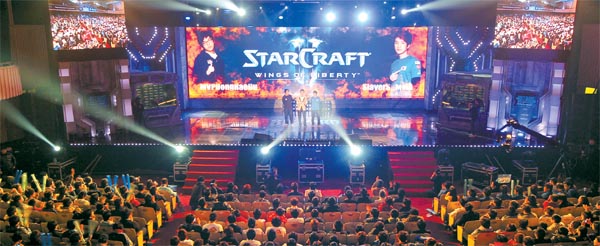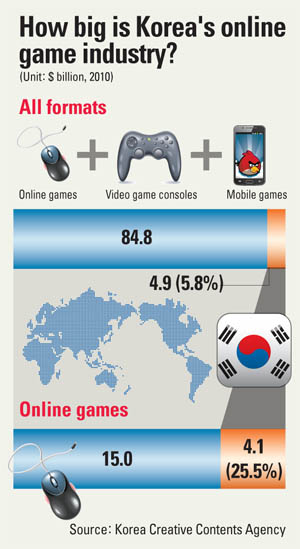E-sports spread from PC bang to world stage

Moon aced the Blizzard Cup at Sejong University in Gunja-dong, eastern Seoul, to pick up the prize money by proving himself the best of the best at the tournament, which featured the hugely popular online game StarCraft II: Wings of Liberty, created by the U.S. video game developer Blizzard Entertainment.
The tournament featured the 10 best players of the award-winning real-time strategy game from around the world and drew hordes of fans to the country to get a glimpse of their favorite professional online gamers in action.
“I came here all the way from Denmark to watch the final,” said a 26-year-old fan who gave his name as Jakob. “If it weren’t for this game, I wouldn’t have visited Korea.” He was one of more than 1,500 online game fans who attended the event.
It was staged at a time when electronic sports, or e-sports, is rapidly growing in popularity around the world - but few nations exhibit as much idolatry as in Korea.

The game’s huge popularity was powered by Internet cafes, known here as PC bangs, which gave birth to a new fad as well as a potential career as a pro gamer.
It also gave birth to the industry and culture dubbed e-sports, with fans tuning in to watch tournaments on TV much as they might watch a game of basketball or football.
“What has changed in the recent year is that fans from around the world have started treating e-sports stars like they would treat their favorite sports superstars or celebrities,” an official from Blizzard Korea said.
“Fans have even created their own culture called ‘BarCraft,’ in which they gather at local bars and clubs to watch e-sports matches together with food and alcohol, and the numbers are growing rapidly,” he added.
Comparing e-sports to the phenomenon of K-pop, which is gaining traction in Europe and the U.S. after first spreading to Japan and Asia, he said, “This industry has also taken a decade to establish itself with a strong fan base.”
The Blizzard Cup featured what in a traditional sport would sound like an all-star cast, with winners of various championships this year, such as the Global StarCraft II League (GSL), Major League Gaming and the Intel Extreme Masters, showing up to do virtual battle.
The top contenders included Jong Hyun-jung, who ranked first in this year’s Global StarCraft II League points ranking, Lim Jae-duck, who ranked second, and France’s Ilyes Satouri, who won entertainment Web site IGN’s Pro League 2.
Moon, who ranked fourth in the GSL points table, emerged as the winner, creating huge drama against his opponent Park Soo-ho, champion of the Intel Extreme Masters NYC, with the two engaging in a close battle as Moon took the first three sets and Park took the next three. With fans staying up late to watch the games all around the world, the finals ended with a score of 4-3, as Moon edged past Park in the final set. The game was broadcast live in 198 countries.
This marked another milestone in both Moon’s career and also the evolution of e-sports, which have created their own superstars such as Lim Yo-han - known among StarCraft aficionados as the “Emperor of the Terran Race.”
As the industry grew in Korea, many big conglomerates have started managing and investing in the teams, including SK, KT, STX and Woongjin. Even the Air Force has gotten involved.
The newly created culture and industry, however, did have its problems. The games were only broadcast in Korean, and few foreign players took part. There was also a paucity of content for fans outside of the country, which made it seem destined to be mostly a Korean phenomenon.
But with the launch of StarCraft II last year, things started to change. New broadcast content was created in Korean, English and Chinese, and fans from overseas began flocking to it. Meanwhile, the Global StarCraft II League started by Korea’s GomTV now ranks as the strongest e-sports league in the world.
By Lee Eun-joo [angie@joongang.co.kr]










with the Korea JoongAng Daily
To write comments, please log in to one of the accounts.
Standards Board Policy (0/250자)